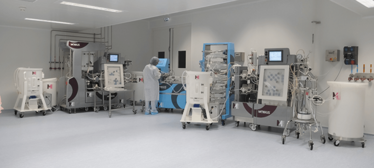The Future of Medicine Manufacture
Economic pressures, new technology and the rise of biologics are all having a huge impact on the pharmaceutical industry. What will the next 10 years hold for drug and biologics manufacture? To answer that question, Gert Moelgaard reviews the factors driving big change in manufacturing and Guillaume Plane takes us on a tour of the facility of the near future.

The New Pharma Reality
As pharmaceutical companies adjust to life after the patent cliff, how are changing trends and fresh challenges affecting the world of medicine manufacture?
For almost a decade, the theme I’ve heard talked about over and over in the pharmaceutical industry is the patent cliff and its anticipated impact on business and profits. Today, most companies are past this precipice, but the world on the other side is very different to the one we were used to. I call this the “new pharma reality.”
Many articles over the last five years have described the consequences of the patent cliff. They predicted that between 2010 and 2015, the value of prescription drug sales would plummet as patents expired and generics entered the market. The reason? Many big pharma companies had failed to come up with enough promising drugs to compensate for the revenue that would soon be lost. Generally, these predictions were very accurate. Over the last 3-5 years we’ve seen some of the largest products in the history of pharmaceuticals lose their patent protection. The ranks among big pharma companies have changed and business models have had to adapt. The resulting job cuts and other cost-containment measures have hit many companies hard. However, we can now see that the predictions only captured a part of the big picture. While the profitability of many of the old blockbusters has declined, new types of pharma products are taking over, especially within the category of specialty drugs.
The new reality of manufacturing
There has been a lot of discussion about the impact of the patent cliff on drug discovery, development and the general business landscape for our industry, but I think a lot of people forget about another very important topic: manufacturing. It may not be clear to everyone just yet, but the challenges that manufacturers face now are very different to those seen when the patent cliff predictions were made.
Back in the so-called ‘blockbuster era’ – before the patent cliff – the most profitable drugs were traditional medicines, mostly oral solid dosage drugs for lowering cholesterol, thinning blood and other common indications. They were manufactured in huge quantities, typically in specialized facilities, with technology that has remained largely unchanged for 50 years. Of course, most of these products still exist on the market, but they now have generic competitors. Coupled with pressure from healthcare payers to cut costs, their value has been so eroded that the holders of some of the big brands are even considering selling them off. Many of these former blockbusters are no longer produced in large dedicated facilities by the originator, but are instead farmed out to contract manufacturers have become part of a much larger portfolio within generic companies.
After the patent cliff, the greatest business value is created by specialty medicines, produced in much smaller quantities. In 2014, products like AbbVie’s Humira, Johnson & Johnson’s Remicade, Pfizer’s Enbrel, Roche/Genentech’s Avastin and other specialty medicines are high up on the list of the most profitable drugs. These specialty medicines have a much higher business value per unit than the high earners in the blockbuster era, such as Pfizer’s Lipitor, Sanofi/BMS’s Plavix or Novartis’ Diovan. With some notable exceptions, today’s specialty medicines are mostly injectables, which require a totally different manufacturing process and technology than the tablets or capsules of the blockbuster era. Starting as a niche area in most companies, aseptic processing has now taken center stage in manufacturing – and for many companies that is a significant challenge.

To complete the picture of the challenges facing manufacturers in the post-patent cliff world, we must note that the new breed of specialty drugs are often offered in pen systems, pumps or other advanced drug delivery systems. This adds complexity to the facilities – and supply chains – of the future. Aforementioned Humira and Enbrel are offered as pens or easy-to-use pre-filled syringes. And though such systems markedly improve patient convenience and compliance, it means that the pharmaceutical facilities of the future will need to master much higher complexity in the manufacturing processes.
It is not only the business complexity of the supply chain but also the complexity of regulatory compliance that has increased. From a good manufacturing practice (GMP) perspective, the challenges of aseptic processing are profound and there have been a number of significant regulatory actions against aseptic facilities over the last few years. Many aseptic processing facilities are quite old, and new technology, including various forms of barrier technology and advanced containment solutions, are being encouraged by pharmaceutical inspectors to mitigate the risks of aseptic processing. In my opinion, regulatory focus has increased; I have seen a number of regulatory presentations at conferences over the last couple of years, pointing to what the facilities of the future should look like to ensure regulatory compliance.
A bigger picture is beginning to emerge of what the new pharma reality for manufacturers may look like. Volume is no longer the priority. Instead, I foresee scalability, flexibility and safety – or regulatory compliance – ‘by design’ to be the drivers when manufacturing the medicines of the future.
Value, not volume, drives design
New specialty medicines are costly, even compared with blockbuster drugs at their peak. They are produced in small or medium volumes, but the business risk of manufacturing them is high. Demand is hard to predict, so bottlenecks can easily occur; flexibility is one of the most important factors for success when manufacturing specialty drugs and avoiding shortages. The new blockbusters, such as Biogen Idec’s Tecfidera and Gilead’s Sovaldi, are setting new records for successful drug market launches, but this is adding significant pressure on the manufacturing organization that has to supply the products.
Most pharma companies have reacted to the patent cliff by streamlining operations and cutting costs, with initiatives in particular focusing on lean manufacturing, six sigma, de-bottlenecking and supply chain management. Manufacturing has been a prime target for rigorous cost-cutting, but many of these measures were designed with the stable production of large volumes in streamlined facilities in mind. They are less effective when volumes are small and flexibility is important. Today, several of the old facilities for some of the biggest products have been sold or are up for sale after the launch of generic competitors.
Pharmaceutical companies require a new combination of cost-effective manufacturing and high flexibility. It is new to the pharmaceutical industry, but the automotive industry faced up to this reality many years ago when it turned from dedicated facilities to flexible manufacturing. From having dedicated manufacturing lines for each car model, the car industry has moved to manufacturing units that make full use of just-in-time principles and high flexibility, even at lower manufacturing costs. Pharma must now make the same shift.
Part of the answer for many companies is to team up with contract manufacturers for some or all of their production volume. Contract manufacturers have flexibility in their DNA – they are often dealing with multiple projects at any time and the tight margins of the business force them to be cost-effective. Besides, they can build an economy of scale by combining manufacturing of similar products from different customers, where possible. Traditional pharma companies could learn a lot from these companies.
New technology
Pharmaceutical manufacturing has seen a number of new technologies emerge over the last 10 years: single-use technology for biopharmaceuticals, isolator technology for aseptic processing, and new inspection and sterilization technologies, to mention just a few. Some have the potential to become disruptive innovations, whereas others may exist side-by-side with traditional technologies. When considering new manufacturing technologies, the old dilemma of balancing the initial investment with the cost of manufacturing (including depreciation) is ever present. But there are some solutions now coming onto the market that are relatively cost-effective to implement. As Guillaume Plane discusses in depth here, single-use systems are a good example since they offer benefits in both cost and flexibility. They have seen rapid uptake in biopharmaceutical production and have significantly reduced the cost of new facilities. In aseptic filling, the adoption of ready-to-use syringes and other primary components could reduce filling line complexity by eliminating processes for washing and sterilization. In packaging, in-line printing holds similar potential by eliminating storage, reconciliation and other packaging support activities.
Other new technologies require a higher investment at the outset, but result in more cost-effective processes. Continuous manufacturing is one of these, but adoption has been slow. There are only a few suppliers and the technology is expensive, but with FDA and EMA endorsement and new regulations that facilitate implementation, widespread use may perhaps be in sight. When this technology reaches economy of scale, with its lower requirements on space, handling and batch management, the balance of investment versus operational cost could shift dramatically. It’s an exciting time to be re-evaluating manufacturing operations and preparing for the future.
Speed to market
At one point, speed to market was not a major concern for pharma companies. Historically, companies developed predictable decision models based on the approval process and market adoption of new drugs, and these worked very effectively during the reign of the blockbusters. Time to market is now crucial, both from a business and a patient perspective. Several regulatory agencies, most notably the FDA, have established programs and initiatives that can speed up the approval time for so-called ‘breakthrough drugs’, such as Roche/Genentech’s Gazyva or Gilead’s Sovaldi. As new drugs that solve unmet needs become more common, pharmaceutical companies will have to re-evaluate their decision-making processes. I expect that we will be facing a new pressure on time-to-market. In this climate, the agility of pharmaceutical manufacturing and fast-track engineering will take on new importance.
Facilities of the future
The drop off the patent cliff period is an opportunity for companies to take a close look at their facilities. Are they using and combining new technologies? Are they cost-effective? Are they flexible enough to cope with changing demands? Are they fit for function in this new reality?
In the facilities being built now, I’ve seen smaller innovations rather than paradigm shifts, but I’m confident that the breakthrough facilities are coming. Several big pharma companies have announced investments in the US, UK, Germany and India for truly inspiring new solutions, some of which can be seen at www.facilityoftheyear.org. The next couple of years could see the launch of facilities with many of the elements that will constitute pharmaceutical facilities of the future.
Gert Moelgaard is Vice President for Strategic Development in NNE Pharmaplan. He has been working in the pharmaceutical industry for more than 25 years and has experience from a number of major projects within pharmaceutical manufacturing, automation systems and validation projects. He is past chairman of ISPE and has made international contributions in international conferences on automation, process validation, pharma industry trends and manufacturing excellence and has contributed to several courses, books and technical guidelines, including FDA’s internal training course for investigators on process validation.



















